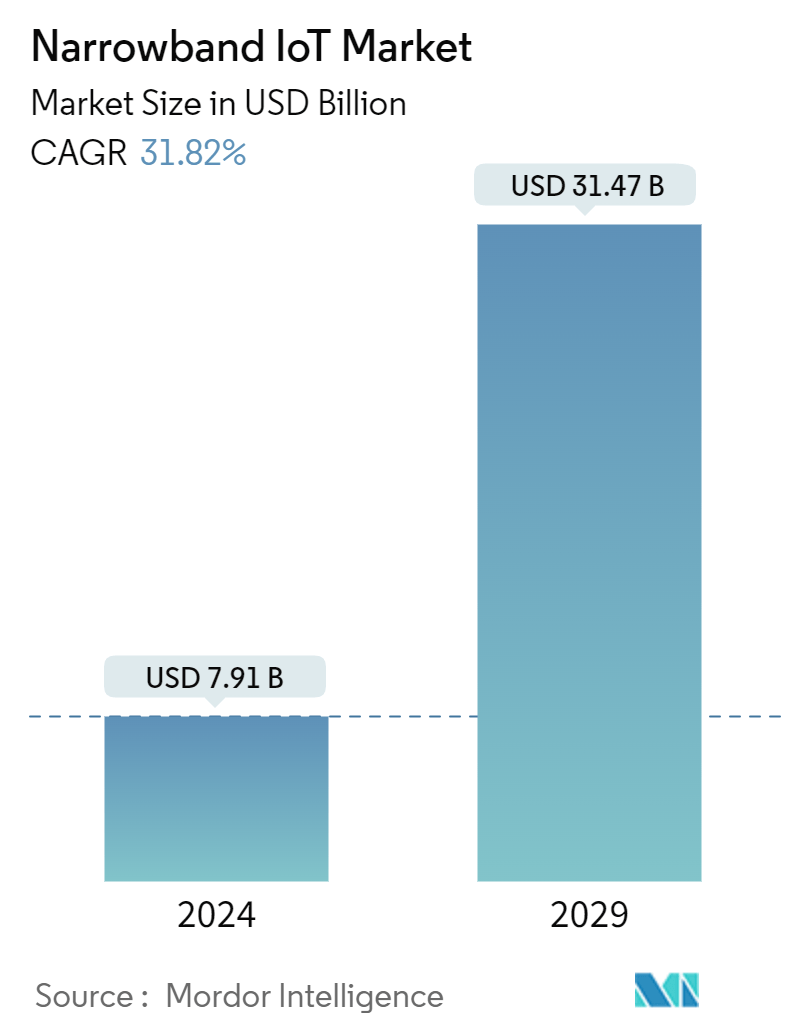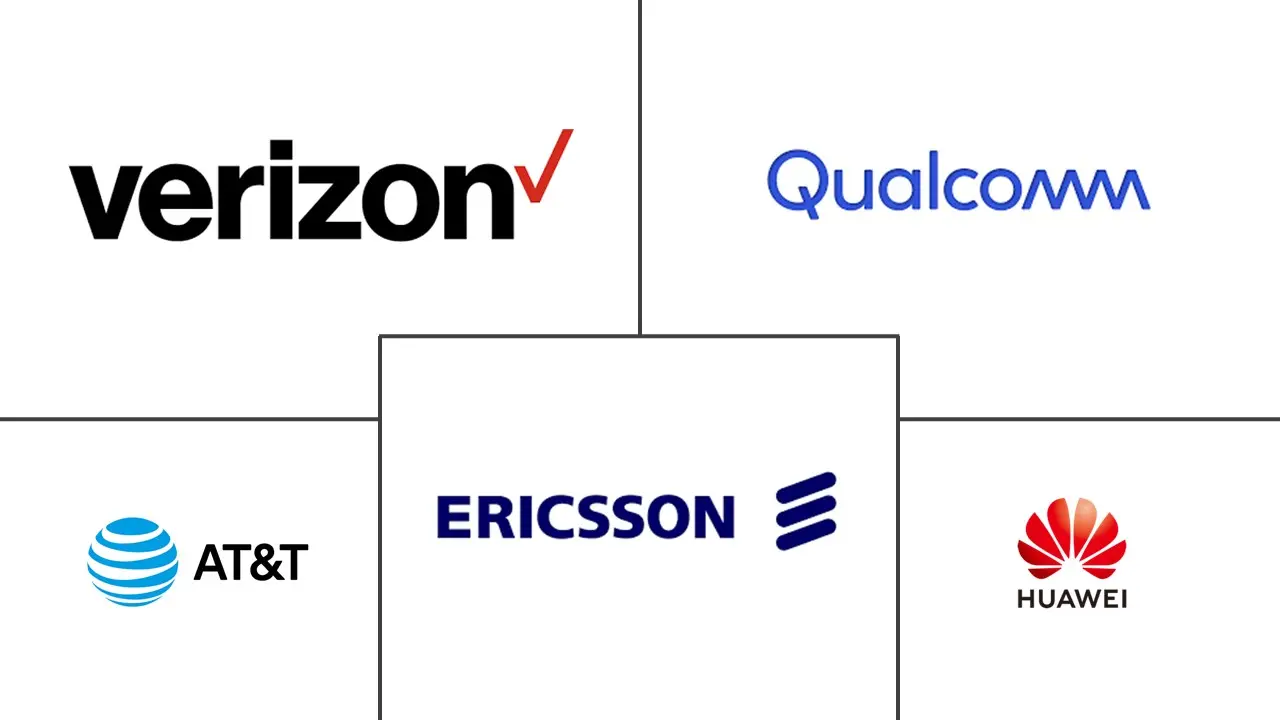Market Size of Narrowband IoT Industry

| Study Period | 2019 - 2029 |
| Market Size (2024) | USD 7.91 Billion |
| Market Size (2029) | USD 31.47 Billion |
| CAGR (2024 - 2029) | 31.82 % |
| Fastest Growing Market | Asia Pacific |
| Largest Market | North America |
| Market Concentration | Low |
Major Players
*Disclaimer: Major Players sorted in no particular order |
Narrowband IoT Market Analysis
The Narrowband IoT Market size is estimated at USD 7.91 billion in 2024, and is expected to reach USD 31.47 billion by 2029, growing at a CAGR of 31.82% during the forecast period (2024-2029).
As a relatively new technology, NB-IoT is still in the early phases of adoption. However, in the upcoming years, it is anticipated to increase quickly.
- The NarrowBand-Internet of Things (NB-IoT) is a standards-based low-power wide area (LPWA) technology designed to support a variety of innovative IoT products and services. NB-IoT dramatically increases system capacity, spectrum efficiency, and user device power consumption, especially in deep coverage.
- NB-IoT is a wireless telecommunications technology standard created by 3GPP, the worldwide standards body responsible for all significant mobile telecommunications standards, including 4G standards like LTE and 5G standards like 5G NR. The NB-IoT modules' low power consumption during signal processing contributes to a ten-year battery life.
- All significant manufacturers of mobile devices, chipsets, and modules support NB-IoT, which can coexist alongside 2G, 3G, and 4G mobile networks. Additionally, it gains the advantages of all mobile networks' security and privacy characteristics, including support for user identity confidentiality, entity authentication, confidentiality, data integrity, and mobile equipment identification.
- In particular, NB-IoT is used in smart cities, smart agricultural, and asset-tracking applications that need low data rates, long battery life, and wide-area coverage. It is ideal for IoT applications that demand massive connectivity since it enables the connection of many devices, generally in hundreds or even millions.
- The wearables sector is also predicted to contribute a major portion of the market due to the fast expanding demand for sports, fitness, and healthcare gadgets for personal care and diagnostics. While the younger population is encouraged to use sports and fitness bands due to rising disposable income levels and increased knowledge of the benefits of physical fitness, the use of healthcare bands is rising in developed nations.
- As a result of the NB-IoT technology's fast-expanding uses, an increasing number of technology firms and telecommunications service providers are projected to develop NB-IoT devices and roll out related services, accelerating market growth throughout the projection period. Big data analytics, artificial intelligence (AI), and machine learning (ML) advancements would allow firms to study enormous volumes of data obtained by watching and monitoring activities via IoT networks.
- Automobile manufacturers are responding to passenger safety concerns by implementing new technology that will undoubtedly provide safer, more convenient, and cost-effective transportation. As a result, NB-IoT is increasingly being used in the automobile industry due to its ability to precisely track vehicles, identify and avoid major traffic jams, and contribute to efficient traffic management.
- Additionally, the capacity of the NB-IoT network to reach deep underground and enclosed locations would allow for the deployment of IoT devices indoors and underground. However, the impending lack of standardized and affordable network pricing models and sufficient network coverage to support the vastly expanded IoT deployments limits industry growth.
Narrowband IoT Industry Segmentation
NarrowBand-Internet-of-Things (NB-IoT) is a standards-based low power wide area (LPWA) technology that has been created to enable a variety of new IoT devices and applications. NB-IoT dramatically improves user device power consumption, system capacity, and spectrum efficiency, particularly in deep coverage. For a wide range of use scenarios, battery life of more than ten years can be supported.
The Narrowband IoT market is segmented by component (network, module), by deployment (standalone, in-band, guard-band), by device type (wearables, tracker, smart meter, smart lighting, alarm & detector, and others), by application (smart cities, transportation & logistics, energy & utilities, retail, agriculture and others), and geography (North America [United States, Canada], Europe [United Kingdom, Germany, France, Rest of Europe], Asia Pacific [India, China, Japan, Rest of Asia Pacific], Latin America [Brazil, Argentina, Rest of Latin America], Middle East and Africa [United Arab Emirates, Saudi Arabia, Rest of Middle East and Africa]). The market sizes and forecasts are provided in terms of value in USD for all the above segments.
| By Component | |
| Network | |
| Module |
| By Deployment | |
| Standalone | |
| In-band | |
| Guard-band |
| By Device Type | |
| Wearables | |
| Tracker | |
| Smart Meter | |
| Smart Lighting | |
| Alarm & Detector | |
| Others |
| By Application | |
| Smart Cities | |
| Transportation & Logistics | |
| Energy & Utilities | |
| Retail | |
| Agriculture | |
| Others |
| By Geography*** | |||||
| |||||
| |||||
| |||||
| Australia and New Zealand | |||||
| |||||
|
Narrowband IoT Market Size Summary
The Narrowband IoT (NB-IoT) market is poised for significant growth, driven by its role as a standards-based low-power wide area technology that enhances system capacity and spectrum efficiency. This technology, developed by 3GPP, is gaining traction in various sectors, including smart cities, agriculture, and asset tracking, due to its ability to support numerous devices with long battery life and extensive coverage. The market is experiencing rapid adoption as it benefits from the security features of existing mobile networks and the support of major manufacturers. The wearables sector, particularly in sports, fitness, and healthcare, is expected to be a substantial contributor to market expansion, fueled by increasing consumer awareness and disposable income. Additionally, advancements in big data analytics, AI, and ML are expected to further propel the market by enabling the analysis of vast data volumes generated by IoT networks.
The NB-IoT market is also supported by government initiatives and smart city projects, which are expected to drive the demand for connected devices such as smart meters and smart transportation systems. North America, with its robust infrastructure and high internet penetration, is a key region for market growth, supported by significant investments in R&D and the adoption of smart connected devices. The region's focus on digitalization and collaboration among network, hardware, and software providers is enhancing the market's expansion. Furthermore, strategic partnerships and technological advancements, such as satellite connectivity and asset tracking solutions, are facilitating market growth. The market's moderate consolidation is characterized by major companies investing in product development and strategic alliances to capture a larger market share.
Narrowband IoT Market Size - Table of Contents
-
1. MARKET DYNAMICS
-
1.1 Market Overview
-
1.2 Market Drivers
-
1.3 Market Restraints
-
1.4 Value Chain Analysis
-
1.5 Porters Five Force Analysis
-
1.5.1 Threat of New Entrants
-
1.5.2 Bargaining Power of Buyers/Consumers
-
1.5.3 Bargaining Power of Suppliers
-
1.5.4 Threat of Substitute Products
-
1.5.5 Intensity of Competitive Rivalry
-
-
1.6 Assestment of the Impact of COVID-19 on the Industry
-
-
2. MARKET SEGMENTATION
-
2.1 By Component
-
2.1.1 Network
-
2.1.2 Module
-
-
2.2 By Deployment
-
2.2.1 Standalone
-
2.2.2 In-band
-
2.2.3 Guard-band
-
-
2.3 By Device Type
-
2.3.1 Wearables
-
2.3.2 Tracker
-
2.3.3 Smart Meter
-
2.3.4 Smart Lighting
-
2.3.5 Alarm & Detector
-
2.3.6 Others
-
-
2.4 By Application
-
2.4.1 Smart Cities
-
2.4.2 Transportation & Logistics
-
2.4.3 Energy & Utilities
-
2.4.4 Retail
-
2.4.5 Agriculture
-
2.4.6 Others
-
-
2.5 By Geography***
-
2.5.1 North America
-
2.5.1.1 United States
-
2.5.1.2 Canada
-
-
2.5.2 Europe
-
2.5.2.1 Germany
-
2.5.2.2 United Kingdom
-
2.5.2.3 France
-
-
2.5.3 Asia
-
2.5.3.1 India
-
2.5.3.2 China
-
2.5.3.3 Japan
-
-
2.5.4 Australia and New Zealand
-
2.5.5 Latin America
-
2.5.5.1 Brazil
-
2.5.5.2 Argentina
-
-
2.5.6 Middle East and Africa
-
2.5.6.1 United Arab Emirates
-
2.5.6.2 Saudi Arabia
-
-
-
Narrowband IoT Market Size FAQs
How big is the Narrowband IoT Market?
The Narrowband IoT Market size is expected to reach USD 7.91 billion in 2024 and grow at a CAGR of 31.82% to reach USD 31.47 billion by 2029.
What is the current Narrowband IoT Market size?
In 2024, the Narrowband IoT Market size is expected to reach USD 7.91 billion.

